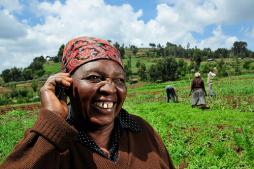Mobile phones may be one mechanism to increase effectiveness and efficiency for agricultural extension in low-income countries. Agricultural extension, broadly defined as the delivery of information to small-scale farmers, was developed to counteract information asymmetries suffered by farmers with limited access to information sources like landline phones, newspapers, radios and TV programming. This has meant that farmers have not been able to take advantage of innovations in agricultural production (from seed types to information about pest control or crop rotations) and have been largely unable to increase their yields and hence incomes.
While agricultural extension programs have tried to counteract this lack of information, they have also been long plagued by lack of scale, sustainability, relevance and responsiveness. Mobile phones, with their low-cost and capability for quick communication, may resolve many of these obstacles.
Dial “A” for Agriculture: A Review of Information and Communication Technologies for Agricultural Extension in Developing Countries, by Jenny C. Aker, a well-known researcher in the field, provides a broad overview of the shift toward using mobile phones in extension services and offers critical guides for assessing the effectiveness of such programs.
Half a century ago, extension programs were conceived to fill the glaring gap between agricultural innovation and crop yields. Despite great advances in agricultural innovations in the latter part of the twentieth century, farmers in Latin America and especially Sub-Saharan Africa have only seen slight increases in yields. Extension programs,which have largely taken the form of in-person visits and training, have consistently suffered from questions of cost-effectiveness.
With the growing ubiquity of mobile phones in low-income countries and cost-effectiveness of mobile services, many agricultural extension initiatives have begun moving toward mobile phone-based programming. Such programs include voice-based information delivery services, SMS-based services, and E-learning programs. These services tend to provide information such as market prices, weather, technical advice, and transport costs. One exciting example, an initiative of Scientific Animations Without Borders, uses animated videos designed to be viewed on mobiles. The government of Kenya has created the National Farmers Information Service, which uses ICT - principally internet and voice services for those using mobile phones - to provide comprehensive information to farmers. The whole of the Grameen Foundation’s agricultural programming in based around mobile technology.
New ICT-based programs need to be assessed rigorously though, not only to establish causation but also to assess if the programs are best suited to supplementing traditional extension work, and if they are cost-effective. Examination is also needed to determine what types of information are best suited to these means of communication, and what the real demand for such services is. African Soil Information Service Labs is currently undertaking a pilot project of soil mapping in Tanzania which will require more complex communications over mobile phones and will be interesting to follow in its progress.
Jenny C. Aker foresees several problems in assessing mobile-based extension programs including isolating the effect of the extension program from the overall effect of owning a mobile phone, that some more complex farming information may not lend itself to such modes of communication. Aker also provides several recommendations on ways to minimize these effects and best analyze the effectiveness of mobile-based agricultural extension programs.
Photo courtesy of Flickr user CIAT International Center for Tropical Agriculture


Post new comment